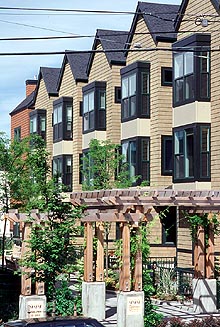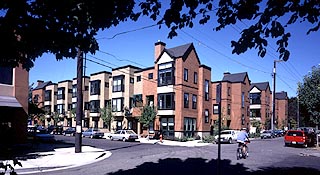|
Subscribe / Renew |
|
|
Contact Us |
|
| ► Subscribe to our Free Weekly Newsletter | |
| home | Welcome, sign in or click here to subscribe. | login |
Real Estate
| |
November 11, 1999
Old dairy becomes new neighborhood
Journal staff

Photos by GBD Architects |
The area around the Belmont Dairy, at Southeast 33rd and Belmont, was a bustling trolley neighborhood in the early part of the century, one of Portland's original subdivisions. The dairy operated until 1990 when the property was purchased from the bankruptcy trustee, according to Douglas Obletz, one of the project developers.
Obletz and his partner Carter MacNichol this month will receive an award for creating a new transit-based community at the site. The Ahwahnee Award is presented by the American Institute of Architects, the American Planning Association and the Center for Livable Communities. The award is named after the Ahwahnee Principles, a set of planning concepts designed to create livable communities with a healthy natural environment and a good quality of life. The awards recognize successful pedestrian-oriented and transit-based communities.
The award is for both phases of the Belmont Dairy project. The $14 million first phase was completed in 1996 and includes a Zupan's European-style grocery store, restaurant, small shops and 85 mixed-income apartments.

|
Shiels Obletz Johnsen was project manager for both phases which were designed by GBD Architects of Portland and built by Walsh Construction Co. of Seattle. Mithun Partners of Seattle was consulting design architect on the second phase.
First Amherst Development Group of Buffalo, N.Y., provided venture capital. Other financing came from city loans and low-income housing tax credits.
A third phase is planned and will include 22 live/work units, with space for small businesses on the ground floor and residential units above. GBD Architects is designing that phase and work is expected to start next spring.


